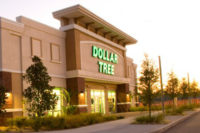The Dollar Store Boom
By Mary Ellen Kuhn
As a moderately priced offer, candy also fits nicely
with the value positioning of dollar stores, he adds.
“The other thing that dollar stores like about
candy is that it’s an easy way to offer brands,” Jones
continues. “It’s harder to offer national brands of more
expensive items.
“But when you walk in there and see those
familiar Hershey’s candy bars and M&M’s and all those other
brands, it gives you a sense that this store is for people like me.”
Add to that the fact that the basket ring at dollar
stores is lower than in channels such as grocery stores, supercenters and
wholesale club stores, and the significance of candy to the channel is
further underscored.
“If somebody picks up a candy item or two for 50
cents or a dollar or two, it’s good incremental sales,” says
Jones. “If you’re a dollar store and you sell them [shoppers]
an extra dollar [of merchandise], you’ve increased your basket size
significantly.”
There’s a particularly strong opportunity to
develop Christmas candy sales, reports Todd Hale, senior vice president,
consumer insights, for ACNielsen, Schaumburg, Ill. December is a heavy
shopping month for dollar stores, he reports, noting that 9.8 percent of
dollar store shoppers’ visits occur during that month.
A frequent stop
Generating impulse sales of candy at dollar stores
should be getting easier, because consumers are shopping them more
frequently than ever before—13 times on average vs. 11 trips annually
in 2001, according to ACNielsen. That is only logical because dollar stores
are America’s fastest-growing retail channel and tend to be found in
convenient, easily accessible locations. Last year, ACNielsen reports, 67
percent of U.S. households shopped in a dollar store.
“People are changing the way they shop,”
Jones continues. “People are taking more short trips. The rise of
candy in dollar stores reflects the way retail is going today,” he
continues. “Shoppers are going into more outlets to buy a few items.
You shop where you stop.”
Behind the boom
Why is the dollar store channel so hot? Numbers tell
some of the story.
Members of the average, reasonably affluent American
household may not realize it, but the median household income has declined
in the United States. Between 1999 and 2003, median household income
dropped from $44,922 to $43,318, reports David Bishop, a director at
Barrington, Ill.-based Willard Bishop Consulting.
| Dollar Store Future Forecast | ||
| 2004 | 2009 | |
| Number of Stores | 18,000 | 24,405 |
| Total Annual Sales (in billions) | $12.2 | $18.1 |
| Share of Grocery/Consumables Sales | 1.5% | 2.0% |
| Source: Willard Bishop Consulting Store Format Report, June 2005 | ||
He adds that two fast-growing population
segments—Hispanics and seniors—tend to have more members with
incomes lower than the median, which should also support growth of the
dollar channel.
“We’re seeing a change in the demographic
makeup of the United States,” says Bishop, who also cites economic
conditions likely to support continued strength within the dollar channel.
He points out that consumers, buoyed by low mortgage and interest rates,
have continued to spend in recent years despite a lukewarm economic climate
and thus have saved less and acquired more debt.
As interest rates start to increase again, there will
be an even greater demand for value shopping opportunities, Bishop
predicts.
What is more, he notes that the dollar store market is
far from saturated in many parts of the country.
“Just from a market presence standpoint, the two
leading players—Dollar General and Family Dollar—are still
limited primarily to east of the Mississippi,” says Bishop.
“And even Dollar Tree, which is in the 48 continuous states, still
has a lot of room to grow.”
Seventy-five percent of dollar store shoppers live
within five miles of the store they shop, so the market can support a large
number of stores. “That’s what we’ve seen in the
Southeast—a tremendous concentration of stores without a noticeable
impact on sales,” Bishop points out.
Sweet opportunities
Willard Bishop Consulting estimates total dollar store
count at about 18,000 in 2004 and forecasts that the total will increase by
36 percent to 24,405 by 2009, so it’s not hard to see the opportunity
for candy, which currently ranks as the No. 1 category in dollar sales for
the channel.
“My guess is that it will continue to be a key
category for the [dollar] channel and offer growth opportunities,”
says ACNielsen’s Hale, citing the prevalence of stores and the
opportunity to further develop impulse candy sales.
Branded candy will probably continue to fare well as
dollar store chains opt to expand their assortment, Bishop predicts.
“As a Dollar General or Family Dollar wants to go more mainstream,
it’s important for their products to appeal to a more mainstream
consumer … so that’s more of an incentive to stock
brands,” he observes.
| A Look at Some Major Players | |||
| Dollar General | Family Dollar | Dollar Tree | |
| Annual Revenue (in billions) | $7.7 | $5.3 | $3.1 |
| Revenue Change | +12% | +11% | +12% |
| Same Store Sales Change | +3.2% | +1.9% | +.5% |
| Number of States | 30 | 44 | 48 |
| Source: ACNielsen, May 2005, based on latest available quarterly or annual reports | |||
Jones cites research that has demonstrated the
priority that price-conscious shoppers place on branded merchandise.
“You would think that the people who can least afford branded are the
least likely to buy it,” says Jones. “Wrong,” he
continues. “People who can afford it are more likely to take a chance
on an unbranded item. People who can least afford it like the idea of
buying a branded candy bar at a value.”
| Candy on Top in Dollar Stores | |
| (Top 10 Categories and % Change vs. Year Ago; Ranking Based on Dollar Sales in 2004) | |
| Candy | +11% |
| Paper Products | +14% |
| Detergents | +2% |
| Stationery, School Supplies | +15% |
| Snacks | +20% |
| Wrapping Materials and Bags | +13% |
| Household Cleaners | +9% |
| Pet Food | +23% |
| Laundry Supplies | +17% |
| Batteries and Flashlights | +12% |
| Source: ACNielsen Homescan, 52 weeks ending Dec. 25, 2004 | |
Category development
There’s room for improvement in the approach
many dollar chains take to candy merchandising, however. For one
thing, there’s a clear need for better front-end merchandising,
Bishop points out.
Display shippers could help do the trick, he
emphasizes. “They really support the mandate of reducing labor within
the store. If a shipper goes in the store, it would have high visibility
because there aren’t a lot of high-impact graphics in the dollar
store.”
Improved merchandising fixtures for candy and better
merchandising in general will become increasingly important for dollar
stores, Bishop continues, noting that as the channel matures, retailers
will be searching for same-store growth opportunities.
In fact, Bishop continues, there will be increased
margin pressure as the dollar channel matures and retailers need to invest
more heavily in it.
Also, as the number of dollar stores increases,
consumer expectations will increase. “Even value consumers will
become more discriminating,” Bishop predicts. “If prices are
the same,” he says, “it will come down to cleanliness and
assortment.”
Single-price-point stores like Dollar Tree and 99
Cents Only will face some of the most severe margin pressure, the experts
predict.
“The biggest challenge that they [stores with a
single price point] are going to face is margin compression with the
continually escalating cost of goods,” says Bishop. “It’s
very hard to maintain a single-price-point strategy when the cost of goods
goes up,” he continues. “They’ve mitigated it by
leveraging their purchasing skill with more imported products or by
shifting to a proprietary brand strategy. That can only last for so long.
You may see them shifting from nothing for more than $1 to nothing for more
than $2.”
ACNielsen’s Hale sees an opportunity for dollar
stores to sell even more candy—particularly with the development of
expanded format stores like the ones Dollar General has been experimenting
with. “I think there’s an opportunity to drive more dollar
sales per trip by focusing on bigger packages.”
Competing for candy sales
The positive growth forecast for candy in dollar
stores, may come at the expense of other retail channels.
According to Information Resources Inc. (IRI)
research, candy (either chocolate or non-chocolate) is the No.1 “trip
traffic” category in mass merchandisers, drug stores and dollar
stores. (Trip traffic refers to the percentage of channel/category buyers
purchasing a product category within a year-long period as a percent of
total U.S. shoppers.)
In the September 2004 issue of IRI’s
“Times and Trends,” the company points out that, “given
the current economic climate, mass is apt to see more of its lower-income
customers shifting candy purchases to dollar stores and aggressive food and
beverage promoting drug chains.” Thus, dollar stores may represent an
increasingly serious competitive threat to mass merchandisers in high
“trip traffic” categories, including candy.
Still, though, the Bentonville-based retailing
behemoth, for one, is not likely to ignore the dollar store competition.
“Wal-Mart is not going to let them
undersell,” says Jones. “If the dollar store sells singles for
45 cents, then Wal-Mart will sell it for 44 cents.” n
Dollar Store Demographics
The dollar channel developed to meet the needs of
lower-income consumers looking for a place to buy household staples at a
bargain price, but dollar store demographics have been changing. The
profile of monthly dollar store shoppers indicates that 29 percent have
incomes of $50,000 or greater, according to recent data from RetailForward,
a Columbus, Ohio-based consulting and market research company.
Still, though, dollar stores function mainly to
provide a shopping solution for less affluent consumers. A total of 55
percent of monthly dollar store patrons have household incomes of less than
$35,000, RetailForward reports. And saving money is the single most
important reason that dollar store shoppers give for spending more in this
channel.
The Delights of Dollar Stores
Dollar store shopping is an enjoyable experience for
most shoppers. According to research by Columbus, Ohio-based RetailForward,
73 percent of dollar store shoppers say they enjoy the experience.
“Consumers like dollar stores because they
associate them with a ‘treasure hunt’ or a search for a
‘good deal,’” says Laurie Demeritt, president and COO of
The Hartman Group, a Bellevue, Wash.-based consulting company.
In fact, says Demeritt, a recent Hartman Group study
found that shoppers perceived dollar stores as sort of a
“weird” environment, but weird in a good way, she adds.
What is more, 83 percent of dollar store shoppers say
they will continue to patronize them even when the economy improves,
RetailForward reports.
Our Information Providers
ACNielsen
Schaumburg, Ill.
(847) 605-5000
Dechert-Hampe & Co.
Northbrook, Ill.
(847) 559-0490
The Hartman Group
Bellevue, Wash.
(425) 452-0818
Information Resources Inc.
Chicago, Ill.
(312) 726-1221
Retail Forward
Columbus, Ohio
(614) 355-4000
Willard Bishop Consulting
Barrington, Ill.
(847) 381-4443




